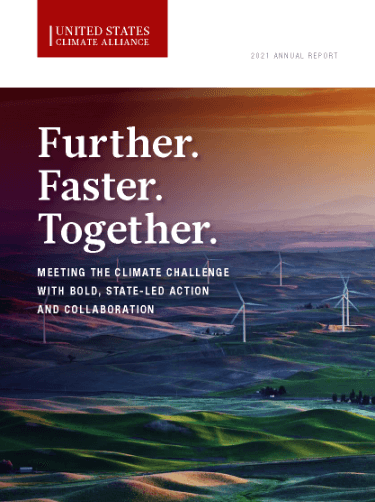Home / U.S. Climate Alliance Releases 2021 Annual Report, Details Pathway to Achieve 2030, 2050 Climate Goals Through Collective State-Federal Action

WASHINGTON, D.C. – Weeks after announcing the next generation of high-impact climate actions its states will pursue to limit warming to 1.5 degrees Celsius at COP26, the U.S. Climate Alliance today released its annual report, “Further. Faster. Together.” which details how states are delivering on their climate commitments and finds that the U.S. and Alliance can achieve their 2030 and 2050 climate goals through collective state-federal action. The U.S. Climate Alliance is a bipartisan coalition of U.S. governors leading states that collectively represent 62% of U.S. GDP, 56% of the U.S. population, and 43% of U.S. emissions.
“As you will see in this report, the Alliance and our states have made significant progress over the past year and the policies and programs we have put into place continue to drive emissions reductions. But the road ahead is long, and we know we are just getting started,” said the Alliance’s co-chairs New York Gov. Kathy Hochul, Washington Gov. Jay Inslee, and California Gov. Gavin Newsom in their Annual Report message. “Our own analysis charts one possible pathway forward, and we will continue to work together to put the next generation of climate policies in place to get it done.”
While the Alliance’s states have made progress in cutting greenhouse gas (GHG) emissions to date, more work needs to be done to avoid catastrophic climate change in the years ahead. To better understand the largest opportunities for Alliance members to work together — and with the federal government — to achieve their collective climate goals, the Alliance commissioned independent analysis of several emissions reduction scenarios.
According to this analysis, if all Alliance members put into place policies and programs to meet their individual GHG targets, they would collectively reduce their emissions by 43 percent below 2005 levels by 2030 and 84 percent by 2050, putting the Alliance’s climate goals within reach. Critically, with additional actions by the executive branch and Congress, the analysis shows that there is a pathway to reduce collective net GHG emissions to at least 50–52 percent below 2005 levels by 2030 and to achieve overall net-zero GHG emissions as soon as practicable and no later than 2050.
Specifically, this analysis shows that Alliance members, working in coordination with the federal government, can meet their collective 2030 and 2050 emissions-reduction goals through collective action to:
The Annual Report also outlines the foundational state climate actions from the Alliance’s members in recent years, which the federal government has already built upon to move the country closer to achieving the goals of the Paris Agreement. This includes bold action from Alliance states to adopt clean car standards, phase-out hydrofluorocarbons (HFCs), establish civilian climate corps, operate green banks, set aggressive conservation goals, make significant environmental justice investments and build resilient infrastructure. The report also catalogues dozens of examples of how Alliance states are delivering on their climate commitments and moving aggressively on all fronts, across all sectors by:
Finally, the report notes the Alliance’s next generation of innovative, high-impact, state-led actions to help ensure the country’s climate goals are durable and progress continues, regardless of who is in power in Congress or the White House.
The full Annual Report and Executive Summary can be read here.
Launched in 2017 by the governors of Washington, New York, and California to help fill the void left by the U.S. federal government’s withdrawal from the Paris Agreement, the Alliance has grown to include 24 governors from across the U.S. representing approximately 60 percent of the U.S. economy and 55 percent of the U.S. population. Governors in the Alliance have pledged to collectively reduce net greenhouse gas emissions by at least 26-28 percent by 2025, 50-52 percent by 2030, and 61-66 percent by 2035, all below 2005 levels, and collectively achieve overall net-zero greenhouse gas emissions as soon as practicable, and no later than 2050.
The Alliance’s states and territories continue to advance innovative and impactful climate solutions to grow the economy, create jobs, and protect public health, and have a long record of action and results. In fact, the latest data shows that as of 2023, the Alliance has reduced its collective net greenhouse gas emissions by 24 percent below 2005 levels, while increasing collective GDP by 34 percent, and is on track to meet its near-term climate goal of reducing collective greenhouse gas emissions 26 percent below 2005 levels by 2025.
###